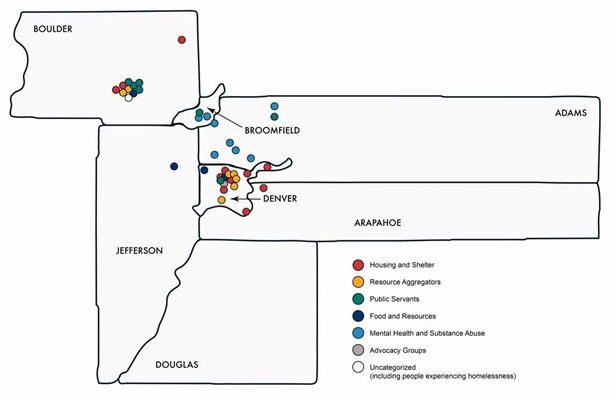External Programs

End Homelessness
Partners
- Common Sense Institute
- Downtown Denver Partnership
- Together Denver
Team
- Dan Griner
- Kelsie Faulds
- Dr. Arriane Collopy
- Lidet Birhanu
- Stephanie Chesler
- Erin Christon
- Marie Evans
Common Sense Institute (external team)
- Brenda Bautsch Dickhoner
- Chris Brown
- Kristin Strohm
End Homelessness
Homelessness is a visible outcome of a system that does not consistently work for everyone and the ecosystem that impacts people experiencing homelessness is vast. It includes individuals, organizations, perceptions, social and societal factors, economic factors, technology, historical factors, and environmental factors. Our team at CU Denver partnered with the Common Sense Institute, the Downtown Denver Partnership, Together Denver and other local associations and business leaders to conduct an economic analysis of the organizations serving individuals experiencing homelessness within the city of Denver and the broader seven-county Metro Denver. Building on a basic understanding of the economic footprint of those experiencing homelessness, we sought to understand, and visualize, the ecosystem of factors, including individual, localized factors and systemic factors, that contribute to furthering homelessness and that contribute to prevention of homelessness or supporting those experiencing homelessness to move past homelessness.
Our team worked in two phases divided between the two organizations.
- The initial phase was an effort of the Common Sense Institute that involved the quantitative documentation of current resources dedicated to the various parts of the homelessness ecosystem for the purpose of understanding the economic footprint.
- In the second phase which was the focus of our Inworks Team, we underwent a qualitative understanding of the ecosystem. In this, seventy-two organizations were contacted, and purposely included both large and small organizations. Outreach was conducted by phone, email, and by in-person contact leading to conversations with 30 unique organizations.

Map of stakeholder outreach. Note that there are more locations than conversations because organizations with multiple locations are shown as in all locations.
The aggregate of all conversations with organizations and individuals informed the development of a Homelessness Ecosystem systems map, or influence diagram, which visually illustrates the connection between relevant factors. The primary value of systems mapping is its use as a tool to make sense of a large space that is seen and experienced differently by many people. Our Homelessness Ecosystem systems map reveals which factors have outsized impacts and provides insights into where additional interventions and investments might address the root causes of persistent problems and accelerate the positive dynamics within the system.
Interactive map of resources:
Overall systems map of Homelessness Ecosystem. Click here for the full map.
In addition, it highlighted key findings with a prioritized set of six recommendations, which we framed as opportunity areas to invite impactful future innovation. These key findings included:
- Housing Affordability and Accessibility are the largest blockers to long-term solutions across all types of homelessness.
- There are many ways for a person to become homeless or to find themselves in a vulnerable state, and much fewer ways out.
- Trust in the system and the services is a barrier for many people experiencing homelessness.
- Stronger collaborations and partnerships at every level are a must for continued growth and better outcomes.
- Increasing reliance on technical solutions for the public, present access challenges for those experiencing homelessness.
- Skilled paid staff are in short supply and this presents a challenge to consistent, effective management and running of organizations.
- Positive outcomes for each individual experiencing homelessness or in danger of becoming homeless vary widely and require a more educated understanding of the many types of people that are represented and the needs that they have.
Both the Colorado Sun and Colorado Politics each wrote an article on the findings.